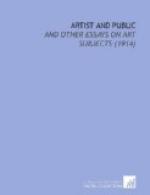[Illustration: Plate 16.—Raphael. “Jurisprudence.” In the Vatican.]
This single room, the Camera della Segnatura, marks the brief blossoming time of Raphael’s art, an art consummate in science yet full of a freshness and spontaneity—the dew still upon it—as wonderful as its learning. The master himself could not duplicate it. He tried for Venetian warmth of color in the “Mass of Bolsena” (Pl. 17) and experimented with tricks of illumination in the “Deliverance of Peter” (Pl. 18), and in these two compositions, struck out new and admirable ways of filling pierced lunettes. The balancing, in the one, of the solitary figure of the pope against the compact group of seven figures—a group that has to be carried up above the curved screen in order to counteract the importance given to Julius by his isolation and by the greater mass of his supporting group below—is a triumph of arrangement; and here, again, it is notable that the bleeding wafer, the necessary centre of interest, is situated on a straight line drawn diagonally from the keystone of the arch to the centre of the window head, and almost exactly half-way between these two points, while the great curve of the screen leads to it from either side. In the symmetrically pierced lunette opposite, the distribution of the space into three distinct but united pictures, the central one seen through the grating of the prison, is a highly ingenious and, on the whole, an acceptable variant on previous inventions. But these two are the last of the Vatican frescoes that show Raphael’s infallible instinct as a composer. He grows tired, exaggerates his mannerisms, gives a greater and greater share of the work to his pupils. The later Stanze are either pompous or confused, or both, until we reach the higgledy-piggledy of the “Burning of the Borgo” or that inextricable tangle, suggestive of nothing so much as of a dish of macaroni, the “Battle of Constantine,” a picture painted after the master’s death, but for which he probably left something in the way of sketches.
[Illustration: Plate 17.—Raphael. “The Mass of Bolsena.” In the Vatican.]




